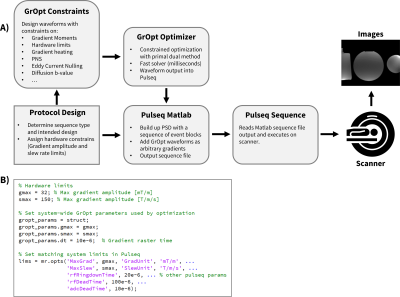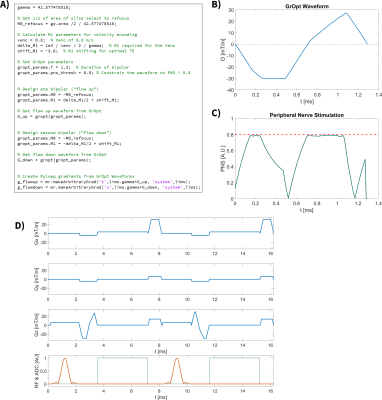Michael Loecher1,2, Judith Zimmerman1,3, Matthew J Middione1,2, and Daniel B Ennis1,2,4
1Radiology, Stanford University, Stanford, CA, United States, 2Radiology, Veterans Affairs Health Care System, Palo Alto, CA, United States, 3Computer Science, Technical University of Munich, Garching, Germany, 4Cardiovascular Institute, Stanford University, Stanford, CA, United States
1Radiology, Stanford University, Stanford, CA, United States, 2Radiology, Veterans Affairs Health Care System, Palo Alto, CA, United States, 3Computer Science, Technical University of Munich, Garching, Germany, 4Cardiovascular Institute, Stanford University, Stanford, CA, United States
The combination of two open-source MRI software packages is
demonstrated: GrOpt for designing time optimal numerically optimized sequences,
and Pulseq for easy generation of pulse sequences that run on a scanner. Sequence development was demonstrated, and an
example of PC-MRI is presented.

Figure 1: A) Shows a flowchart of
the process for using GrOpt to build waveforms to enter into Pulseq. B) Shows
how the system and hardware constraints are initially shared to initialize the
GrOpt optimization and Pulseq limits in the code example.

Figure 3: Summary of designing
PC-MRI sequence with GrOpt and Pulseq.
A) Gives a code snippet of relevant portions of the sequence design
code. Some initial gradient and RF
creation omitted for space. B) Shows the
waveform designed by GrOpt. C) Shows the
PNS response of the B), where the PNS does not exceed the 0.8 limit imposed. The
optimal design slews quickly before the PNS limit, then the slew rate derates
accordingly. D) Shows two TRs of gradient waveforms as output by Pulseq, with
the GrOpt bipolars played out in the z direction after slice select.
